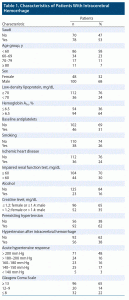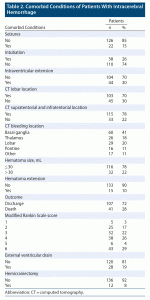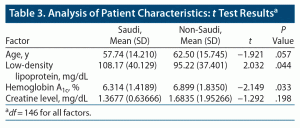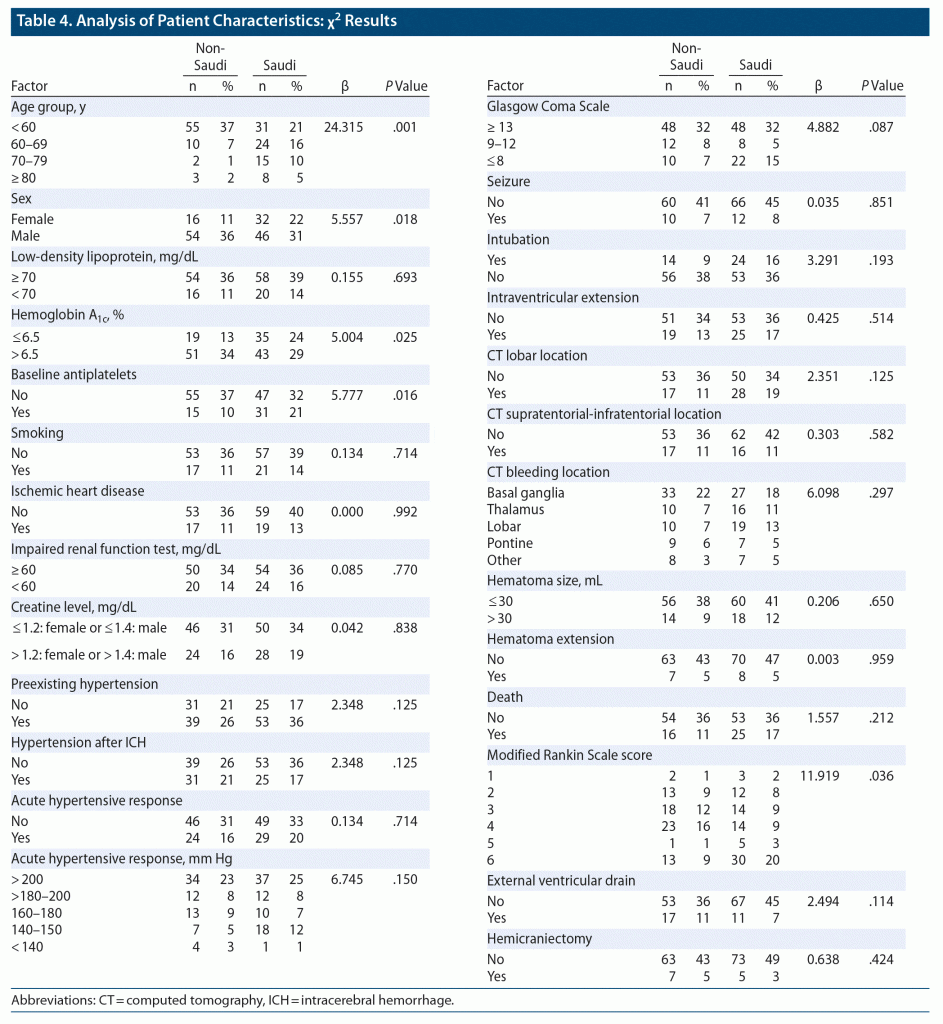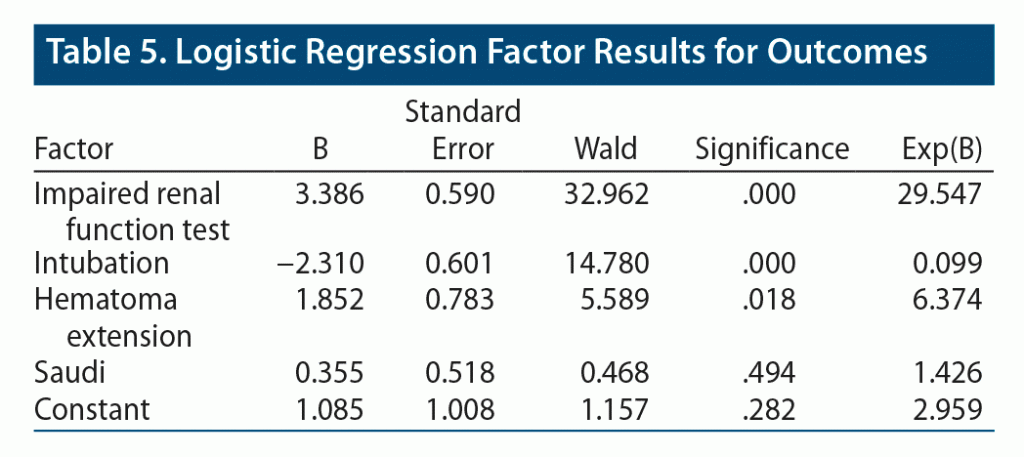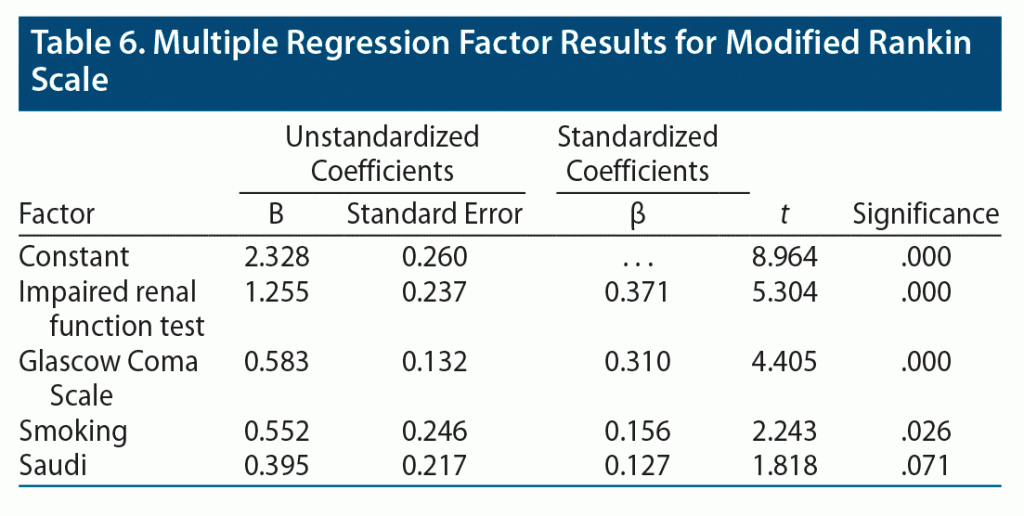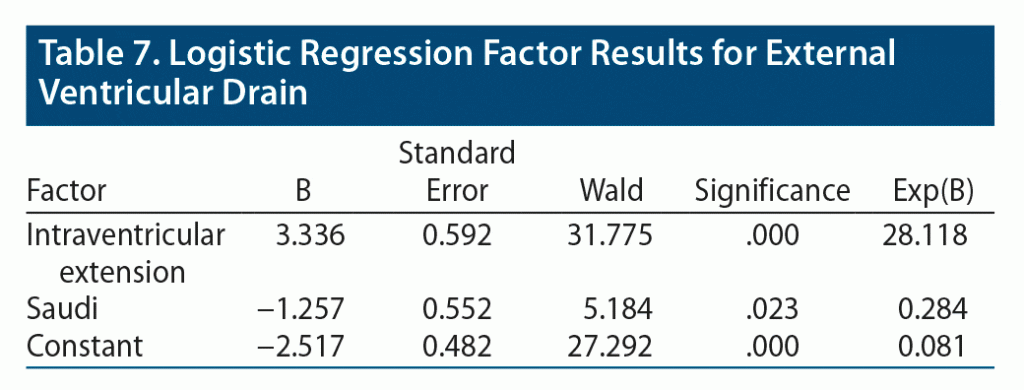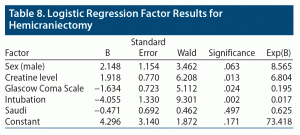ABSTRACT
Objective: Intracerebral hemorrhage (ICH) is the second most common subtype of stroke. The objective of this study was to identify differences between Saudi and non-Saudi patients regarding demographics, clinical conditions, and associated ICH outcomes.
Methods: This retrospective study included patients with ICH (ICD-10 code I61) admitted to a university hospital in Saudi Arabia from April 2014 to April 2019. ICH prevalence patterns were divided into 4 age groups: aged < 60, 60–69, 70–79, and ≥ 80 years. Patient data were collected from the hospital stroke registry. Several outcomes were investigated including death, modified Rankin Scale (mRS) score, external ventricular drain (EVD), and hemicraniectomy. The influence of various demographic and risk factors was studied for each outcome using several analytic techniques.
Results: Of 148 patients, 53% were Saudi and 47% were non-Saudi. Death was reported in 28% of patients and was influenced by many factors including impaired renal function test (> 1.2 mg/dL in females and > 1.4 mg/dL in males) and hematoma size expansion. An unfavorable mRS score after ICH was influenced by impaired renal function test, Glasgow Coma Scale score, and smoking history. EVD insertion was influenced by intraventricular extension of hematoma and being non-Saudi. Hemicraniectomy procedures were associated with impaired renal function test.
Conclusion: Non-Saudi ICH survivors had significant intraventricular extension of hematoma and required more neurosurgical interventions such as EVD procedures compared to Saudi patients. Both groups had associated comorbidities that may influence the incidence of ICH. Appropriate medical care to prevent stroke complications, especially for the older male population, as a strategy for secondary prevention of such neurologic sequelae is recommended.
Prim Care Companion CNS Disord 2022;24(5):21m03192
To cite: Alokley AA, Albakr A. Intracerebral hemorrhages related to clinical conditions and associated outcomes among Saudi and non-Saudi patients in a university hospital: a retrospective study. Prim Care Companion CNS Disord. 2022;24(5):21m03192.
To share: https://doi.org/10.4088/PCC.21m03192
© 2022 Physicians Postgraduate Press, Inc.
aDepartment of Neurology, College of Medicine, King Faisal University, Al-Ahsa, Saudi Arabia
bDepartment of Neurology, King Fahad Hospital of the University, Alkhobar, Saudi Arabia
cDepartment of Neurology, College of Medicine, Imam Abdulrahman Bin Faisal University, Dammam, Saudi Arabia
*Corresponding author: Alia Ali Alokley, MD, King Faisal University, PO Box 400, Hofuf, 31982 Saudi Arabia ([email protected]).
Strokes are defined as a rapid neurologic deficit following interference of the related blood supply. In general, stroke is divided into ischemic and hemorrhagic subtypes.1 In this study, we mainly focused on the entity of hemorrhagic strokes, particularly intracerebral hemorrhage (ICH). ICH accounts for the second most common subtype of stroke.2 Globally, the occurrence of ICH ranges from 12 to 31 per 100,000 people, along with its replication rate every 10 years after age 35 years. It also carries a higher percentage of significant disability and morbidity based on the modified Rankin Scale3 (mRS) system among stroke patients.4,5
It is well acknowledged that ICH occurs due to primary causes, for instance, the breakup of small vessels associated with chronic hypertension or in elderly patients presenting with amyloid angiopathy. Also, secondary causes most often occur due to vascular anomaly or central nervous system tumors.6 Furthermore, its mechanism has been linked to multiple risk factors and associated variables including genetics; demographics; comorbid conditions like diabetes, hypertension, or chronic kidney disease; and antithrombotic use.6
From this perspective, the aim of the present study was to illustrate the differences between the Saudi and non-Saudi population regarding ICH-related demographics, risk factors, clinical courses, and associated outcomes. Limited studies have been conducted among the Saudi population on the precise prevalence and related factors regarding ICH. Yaqub et al7 conducted a study with 200 Saudi stroke patients and found that cerebral hemorrhages occurred in 6.5% of stroke patients. Another study by Awada and al Rajeh8 demonstrated that most of the hemorrhagic strokes were ICH, and only 2% of all strokes were subarachnoid hemorrhage. No further analysis of the significance of associated outcomes has been made.9 Therefore, this retrospective study was designed to demonstrate the differences among the 2 groups regarding ICH outcomes.
METHODS
This study was a quantitative retrospective study, as it sought to investigate the effect of ICH on different variables such as patient demographics, being Saudi versus non-Saudi, premorbid and postmorbid conditions including death incidence, possibility of external ventricular drain (EVD) insertion, and hemicraniectomy status using secondary data from a health management system. The study was conducted at King Fahad University Hospital, Al-Khobar, Saudi Arabia. Data were gathered from the stroke registry at the hospital for patients diagnosed with ICH between April 2014 and April 2019. ICD-10 code I61 was applied, and a standard protocol approval and registrations were obtained from the local institutional review board (ethics committee; Imam Abdulrahman Bin Faisal University, Dammam, Saudi Arabia; IRB no. 2018-01-002). Informed consent was not required, as no patients were contacted, and all data were identified in the King Fahad University Hospital stroke registry.
Study Sample
Patients were identified using the following inclusion and exclusion criteria. The inclusion criteria were limited to patients diagnosed with ICH, past medical history of hypertension, and persistence of an elevated blood pressure (BP) level > 140/90 mm Hg for 2 weeks post-ICH. The exclusion criteria included patients with a history of subdural and epidural hematomas, evidence of traumatic ICH, vascular anomalies or subarachnoid hemorrhage, central nervous system tumors related to hemorrhage, ischemic stroke with hemorrhagic transformation, and other systemic causes of ICH such as nonhypertensive bleeds or antithrombotic use.
Explanatory Variables
Eligible patients were further analyzed per their demographics; ICH prevalence patterns divided into 4 age groups: aged < 60, 60–69, 70–79, and ≥ 80 years; comorbidities such as diabetes mellitus (defined per the World Health Organization); fasting blood sugar level > 126 mg/dL or 2-hour plasma glucose > 200 mg/dL10; and abnormal kidney function as defined by a glomerular filtration rate (GFR) < 60 mL/min/1.73m2.11 Furthermore, an abnormal lipid profile (low-density lipoprotein level [LDL] < 70 mg/dL), smoking status, previous consumption of antiplatelets, alcohol intake, and ischemic heart disease were also assessed.
Patients’ clinical presentations post-ICH were determined by the level of consciousness and assessed with the Glasgow Coma Scale11 (GCS) with scores ranging from mild (GCS: 13–15) to moderate (GCS: 9–12) to severe (GCS: ≤ 8). The patients’ systolic BP levels were classified as mild if the readings were between 140 and 180 mm Hg and severe if > 180 mm Hg, in line with the acute hypertensive response, which is the presence of high systolic BP ≥ 140 mm Hg on 2 recordings taken 5 minutes apart within 24 hours of symptom onset.12
Moreover, the radiologic location of ICH in computed tomography (CT) or magnetic resonance imaging (MRI) scans was also considered and classified as (1) supratentorial: basal ganglia, thalamus, and lobar; (2) infratentorial: brain stem and cerebellum; (3) multiple sites; and (4) primary intraventricular. Accompanied complications such as intraventricular extension, edema, and hydrocephalus were also considered. ICH volume was calculated via the “ABC/2 method” (A: wideness, B: length, and C: height, based on the section number found in the CT)13 and was further classified according to size into < 30 mL and > 30 mL. Head MRI using the modified Boston criteria14 was performed in select patients (those aged > 55 years with lobar hemorrhage) to assess the underlying cerebral amyloid angiopathy.
Outcome Variables
First, patient outcomes were represented by the mRS as 0 = no symptoms; 1 = no significant disability, able to carry out all usual activity; 2 = slight disability, unable to carry out usual activity; 3 = moderate disability, requires help but able to walk unassisted; 4 = moderately severe disability, unable to walk unassisted; 5 = severe disability, requires constant help, bedridden; and 6 = death.15 Second, 30-day mortality was considered. Third, the use of neurosurgical intervention such as hemicraniectomy or EVD insertion as treatment options for post-ICH complications was considered.
Prior to conducting the analysis, a data-cleaning process was implemented to improve the quality of the data and analysis. Several missing data were identified and replaced by the mean for continuous variables and median for categorical variables. A multicollinearity issue was also detected with variance inflation factor scores > 10 for 2 variables: alcohol and preexisting hypertension. Both variables were removed to eliminate the multicollinearity issue. Additionally, several variables were transformed to correspond with the literature.
Various analytic techniques were conducted including t test, χ2, logistic regression, multiple regression, and correlation analysis. t test and χ2 were used for comparative analysis to identify the significant differences between Saudi and non-Saudi patients in terms of the various factors. t test was used to compare the groups with continuous factors, and χ2 was utilized for categorical factors. Logistic regression was used to identify the factors that have an effect, including being Saudi or non-Saudi, as well as for postmortem outcomes including EVD insertion and the hemicraniectomy process. Multiple regression was utilized to determine factors including being Saudi or non-Saudi and mRS score. The analysis was conducted with SPSS version 25.
RESULTS
Descriptive Analysis
Table 1 and Table 2 provide the descriptive analysis results of patient characteristics and comorbid conditions. The results showed that 53% of patients were Saudi, and 47% were non-Saudi, which indicates that the sample was relatively equally divided. Additionally, the mean age of the patient sample was 60 years with a male predominance. Regarding the comorbid status, 64% of participants were diabetic with a hemoglobin A1c (HbA1c) value > 6.5.
Furthermore, the results revealed several associated factors. Only 31% of the patients were taking baseline antiplatelet medications; 62% had uncontrolled preexisting hypertension, 48% had uncontrolled BP with a systolic BP > 200 mm Hg, and 17% had a BP between 150 and 200 mm Hg. Also, most patients (85%) had no history of seizures. Most patients did not drink alcohol (84%), were nonsmokers (74%), and had no history of preexisting ischemic heart disease (76%) or renal failure (70%). Furthermore, most patients (76%) had dyslipidemia (LDL levels > 70 mg/dL).
Furthermore, most participants had a moderate GCS ≥ 13 (65%), and 78% had an ICH volume < 30 mL. The data showed a high incidence of association of ICH with supratentorial bleeds within basal ganglia (41%) and limited extension to intraventricular spaces (90%).
Regarding post-ICH outcomes, 26% had an mRS score of 4, and 30-day mortality occurred in only 28%. In addition, most of the patients did not require either an EVD insertion (81%) or hemicraniectomy (92%).
Comparative Results
Comparative analyses were implemented to measure the significant differences between Saudi and non-Saudi patients in terms of various patient characteristics using t test and χ2 methods. As presented in Table 3, the t test results showed that Saudi and non-Saudi participants had significant differences in LDL and HbA1c levels, which indicated that Saudi patients have a higher mean LDL value (108 mg/dL compared to 95 mg/dL in non-Saudi patients), whereas non-Saudi patients had a higher mean HbA1c value (6.8 compared to 6.3 in Saudi patients) due to various contributing factors including diet regimen, medication compliance, and genetic background between the 2 groups.
Table 4 shows the χ2 results of the 2 groups for several factors. The results indicated that Saudi and non-Saudi participants were significantly different regarding age, as most Saudi patients were aged > 60 years, and non-Saudi patients were aged < 60 years. The results also demonstrated a significant difference between the 2 groups in terms of sex, as there were more male patients in both groups. Additionally, the results showed significant differences between the 2 groups in terms of baseline antiplatelet use and mRS scores. Particularly, the baseline antiplatelet intake results showed that the non-Saudi population had a higher usage of antiplatelets (37%) than the Saudi patients (32%). Finally, Saudi patients had higher mRS scores of 6 (20%) compared to the non-Saudi population of 3 to 4 (16%).
Outcomes
Using logistic or multiple regressions, we explored multiple patient outcomes including deaths, mRS score after ICH, and possibilities for hemicraniectomy and EVD insertion as treatment options after the known complications of ICH.
Deaths. The result of the model fit indicated that the model was able to predict 58% of the death status. Three factors were found to be significant with death, as shown in Table 5. Impaired renal function test and hematoma extension had a positive significant effect on death status, whereas intubation had a negative significant effect on death. The results also indicated that there was no significant effect of being Saudi or non-Saudi on the death outcome.
mRs. With an R square equal to 0.31, 3 significant factors were found to positively influence the mRS score, as presented in Table 6. These factors were impaired renal function test > 1.2 mg/dL in females and > 1.4 mg/dL in males, GCS, and smoking status. However, being Saudi or non-Saudi had no influence on mRS score.
EVD insertion. The model was able to predict 45% of the EVD outcome. The results, as provided in Table 7, showed only 2 factors that influenced the EVD insertion, which were being non-Saudi and the status of intraventricular extension.
Hemicraniectomy. The model was able to predict 31% of the hemicraniectomy outcome. The results in Table 8 demonstrate that creatine levels > 1.2 mg/dL in females and > 1.4 mg/dL in males had a positive significant impact on hemicraniectomy, whereas GCS and intubation status had a negative significant effect on hemicraniectomy. The results also demonstrated that being Saudi or non-Saudi had a nonsignificant influence on hemicraniectomy.
DISCUSSION
The findings of this retrospective study showed no significant effect of being Saudi (local country inhabitant) versus non-Saudi (nonlocal including tourists, visitors, or employees) on the ICH clinical outcome of mRS score, hemicraniectomy procedures, and death. On the other hand, the use of EVD insertion was higher among the non-Saudi group, who had a higher incidence of intraventricular extension of hematoma compared to the Saudi group.
One objective of this study was to explore the association of the significant effect of being Saudi versus non-Saudi on the ICH-related risk factors and comorbid status, as explained earlier in the comparative results and descriptive analysis sections. The statistical analysis was conducted based on a relatively equal distribution of Saudi and non-Saudi patients. The results showed that most Saudi patients were aged > 60 years and male. Alhazzani et al16 and Al-Jadid and Robert17 conducted studies that showed similar results within Saudi Arabia’s stroke registry.9,10
Furthermore, Saudi patients had higher mRS functional baseline scores, LDL ratios > 70 mg/dL, and no previous consumption of antiplatelet medications, which should contribute to worse clinical outcomes for ICH among Saudi patients, but our data demonstrated no such difference between the Saudi and non-Saudi groups regarding death outcome. This result may indicate that dyslipidemia and negative antiplatelet consumption were independent of an ICH death outcome among both groups, and further risk factors need to be addressed.
Interestingly, our study showed no significant effect or influence among the 2 groups on ICH outcomes including hemicraniectomy status and mRS score. On the other hand, being non-Saudi was associated with higher incidence of EVD insertion among survivors due to intraventricular extension of hematoma. Finally, the significant correlation among the 2 groups regarding post-ICH complications has, to our knowledge, not been investigated before. Future studies must conduct further analysis.
CONCLUSION
ICH and clinical outcomes including mRS score, hemicraniectomy procedures, and death among the Saudi versus non-Saudi population were not significantly different. However, certain comorbidities were significant among the 2 groups, which may influence the incidence of ICH and the post-ICH treatment plan. From this perspective, we encourage appropriate medical care that will prevent stroke complications, especially for the older male population, as a strategy for secondary prevention of such neurologic sequelae.
Submitted: November 17, 2021; accepted March 22, 2022.
Published online: October 18, 2022.
Relevant financial relationships: None.
Funding/support: None.
Clinical Points
- Appropriate medical management of comorbidities among intracerebral hemorrhage (ICH) survivors are the mainstay of post-ICH care.
- Non-Saudi ICH survivors had significant intraventricular extension of the hematoma and required more neurosurgical interventions such as external ventricular drain procedures compared to the Saudi population.
- Non-Saudi patients had better modified Rankin Scale scores of 3 to 4 compared to 6 in the Saudi group, which need to be addressed for rehabilitation purposes.
References (17)

- Chandra A, Stone CR, Du X, et al. The cerebral circulation and cerebrovascular disease III: Stroke. Brain Circ. 2017;3(2):66–77. PubMed CrossRef
- An SJ, Kim TJ, Yoon BW. Epidemiology, risk factors, and clinical features of intracerebral hemorrhage: an update. J Stroke. 2017;19(1):3–10. PubMed CrossRef
- van Swieten JC, Koudstaal PJ, Visser MC, et al. Interobserver agreement for the assessment of handicap in stroke patients. Stroke. 1988;19(5):604–607. PubMed CrossRef
- Fischer MA, Das JM Cerebellar Hematoma. In: StatPearls [Internet]. Treasure Island, FL: StatPearls Publishing; Updated May 1, 2022.
- Helal HHAE, Bahnasy WS, Ghali AA, et al. Early hematoma expansion in primary intracerebral hemorrhage: incidence and predictors. Egypt J Neurol Psychiat Neurosurg. 2019;55(1):61. CrossRef
- Aguilar MI, Brott TG. Update in intracerebral hemorrhage. Neurohospitalist. 2011;1(3):148–159. PubMed CrossRef
- Yaqub BA, Shamena AR, Kolawole TM, et al. Cerebrovascular disease in Saudi Arabia. Stroke. 1991;22(9):1173–1176. PubMed CrossRef
- Awada A, al Rajeh S. The Saudi Stroke Data Bank. Analysis of the first 1,000 cases. Acta Neurol Scand. 1999;100(4):265–269. PubMed CrossRef
- Robert AA, Zamzami MM. Stroke in Saudi Arabia: a review of the recent literature. Pan Afr Med J. 2014;17(1):14. PubMed
- Al-Senani F, Al-Johani M, Salawati M, et al. An epidemiological model for first stroke in Saudi Arabia. J Stroke Cerebrovasc Dis. 2020;29(1):104465. PubMed CrossRef
- Jain S, Teasdale GM, Iverson LM. Glasgow Coma Scale. In: StatPearls [Internet]. Treasure Island, FL: StatPearls Publishing; 2019.
- AlSibai A, Qureshi AI. Management of acute hypertensive response in patients with ischemic stroke. Neurohospitalist. 2016;6(3):122–129. PubMed CrossRef
- Kleinman JT, Hillis AE, Jordan LC. ABC/2: estimating intracerebral haemorrhage volume and total brain volume and predicting outcome in children. Dev Med Child Neurol. 2011;53(3):281–284. PubMed CrossRef
- Linn J, Halpin A, Demaerel P, et al. Prevalence of superficial siderosis in patients with cerebral amyloid angiopathy. Neurology. 2010;74(17):1346–1350. PubMed CrossRef
- Broderick JP, Adeoye O, Elm J. Evolution of the modified Rankin Scale and its use in future stroke trials. Stroke. 2017;48(7):2007–2012. PubMed CrossRef
- Alhazzani AA, Mahfouz AA, Abolyazid AY, et al. Study of stroke incidence in the Aseer region, Southwestern Saudi Arabia. Int J Environ Res Public Health. 2018;15(2):215. PubMed CrossRef
- Al-Jadid MS, Robert AA. Determinants of length of stay in an inpatient stroke rehabilitation unit in Saudi Arabia. Saudi Med J. 2010;31(2):189–192. PubMed
Please sign in or purchase this PDF for $40.
